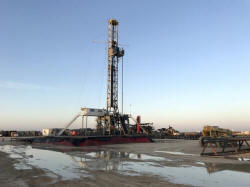Pressured for profit, oil majors bet big on shale
technology
 Send a link to a friend
Send a link to a friend
 [November 28, 2017]
By Ernest Scheyder [November 28, 2017]
By Ernest Scheyder
HOUSTON (Reuters) - Shale oil engineer
Oscar Portillo spends his days drilling as many as five wells at once -
without ever setting foot on a rig.
Part of a team working to cut the cost of drilling a new shale well by a
third, Portillo works from a Royal Dutch Shell Plc <RDSa.L> office in
suburban Houston, his eyes darting among 13 monitors flashing data on
speed, temperature and other metrics as he helps control rigs more than
500 miles (805 km) away in the Permian Basin, the largest U.S. oilfield.
For the last decade, smaller oil companies have led the way in shale
technology, slashing costs by as much as half with breakthroughs such as
horizontal drilling and hydraulic fracking that turned the United States
into the world's fastest-growing energy exporter.
(For a graphic detailing the decline in drilling costs, see: http://tmsnrt.rs/2zCXvxE)
Now, oil majors that were slow to seize on shale are seeking further
efficiencies by adapting technologies for highly automated offshore
operations to shale and pursuing advances in digitalization that have
reshaped industries from auto manufacturing to retail.

If they are successful, the U.S. oil industry's ability to bring more
wells to production at lower cost could amp up future output and company
profits. The firms could also frustrate the ongoing effort by The
Organization of Petroleum Exporting Countries (OPEC) effort to drain a
global oil glut.
"We're bringing science into the art of drilling wells," Portillo said.
The technological push comes amid worries that U.S. shale gains are
slowing as investors press for higher financial returns. Many investors
want producers to restrain spending and focus on generating higher
returns, not volume, prompting some to pull back on drilling.
Production at a majority of publicly traded shale producers rose just
1.3 percent over the first three quarters this year, according to Morgan
Stanley <MS.N>.
But many U.S. shale producers vowed during third quarter earnings
disclosures to deliver higher returns through technology, with many
forecasting aggressive output hikes into 2018.
Chevron Corp <CVX.N> is using drones equipped with thermal imaging to
detect leaks in oil tanks and pipelines across its shale fields,
avoiding traditional ground inspections and lengthy shutdowns.
Ryan Lance, chief executive of ConocoPhillips <COP.N> - the largest U.S.
independent oil and gas producer - sees ample opportunity to boost both
profits and output. Conoco also oversees remote drilling operations in a
similar way to Shell.
"The people that don't have shale in their portfolios don't understand
it, frankly," Lance said in an interview. "They think it's going to go
away quickly because of the high [production] decline rates, or that the
resource is not nearly that substantial. They're wrong on both counts."

Shell, in an initiative called "iShale," has marshaled technology from a
dozen oilfield suppliers, including devices from subsea specialist
TechnipFMC Plc <FTI.N> that separate fracking sand from oil and
well-control software from Emerson Electric Co <EMR.N>, to bring more
automation and data analysis to shale operations.
[to top of second column] |

A drilling rig owned by Parsley Energy Inc. seen near Midland,
Texas, U.S. on May 3, 2017. REUTERS/Ernest Scheyder/File Photo

One idea borrowed from deepwater projects is using sensors to automatically
adjust well flows and control separators that divvy natural gas, oil and water.
Today, these subsea systems are expensive because they are built to operate at
the extreme pressures and temperatures found miles under the ocean's surface.
Shell's initiative aims to create cheaper versions for onshore production by
incorporating low-cost sensors similar to those in Apple Inc's <AAPL.O> Watch,
eliminating the need for workers to visit thousands of shale drilling rigs to
read gauges and manually adjust valves. Shell envisions shale wells that predict
when parts are near mechanical failure and schedule repairs automatically.
By next year, the producer wants to begin remote fracking of wells, putting
workers in one place to oversee several projects. It also would add solar panels
and more powerful batteries to well sites to reduce electricity and diesel
costs.
Oil firms currently spend about $5.9 million to drill a new shale well,
according to consultancy Rystad Energy. Shell expects to chop that cost to less
than $4 million apiece by the end of the decade.
"There is still very little automation," said Amir Gerges, head of Shell's
Permian operations. "We haven't scratched the surface."
TECHNOLOGY AND GEOLOGY
Much of the new technology is focused on where rather than how to drill.
"There is no amount of technology that can improve bad geology," said Mark Papa,
CEO of shale producer Centennial Resource Development Inc <CDEV.O>
Anadarko Petroleum <APC.N>, Statoil <STL.OL> and others are using DNA sequencing
to pinpoint high potential areas, collecting DNA from microbes in oil to search
for the same DNA in rock samples. ConocoPhillip's MRI techniques also borrow
from medical advances.

ConocoPhillips next year will start using magnetic resonance imaging (MRI) to
analyze Permian rock samples and find the best drilling locations, a technique
the company first developed for its Alaskan offshore operations.
EOG Resources Inc <EOG.N> last year began using a detailed analysis of the oil
quality of its fields. The analysis, designed by Houston start-up Premier
Oilfield Laboratories, helps to speed decisions on fracking locations and avoid
less productive sites.
Premier has reduced the time needed to analyze seismic data to find oil reserves
from days or weeks to seconds. Such efficiencies serve two purposes, said Nathan
Ganser, Premier's director of geochemical services.
"It's not only removing costs that are superfluous," he said. "It's boosting
production."
(Reporting by Ernest Scheyder; Editing by Gary McWilliams and Brian Thevenot)
[© 2017 Thomson Reuters. All rights
reserved.] Copyright 2017 Reuters. All rights reserved. This material may not be published,
broadcast, rewritten or redistributed. |